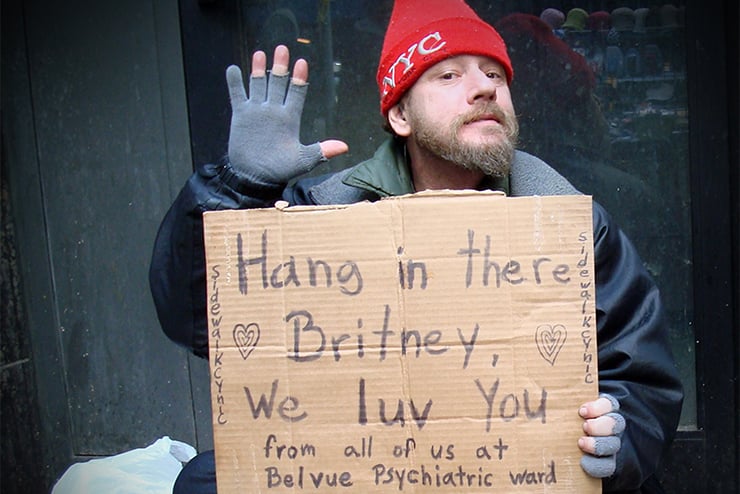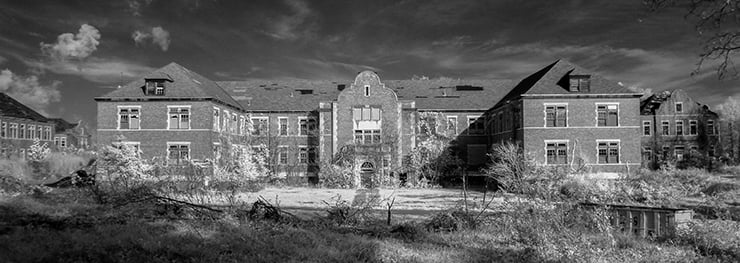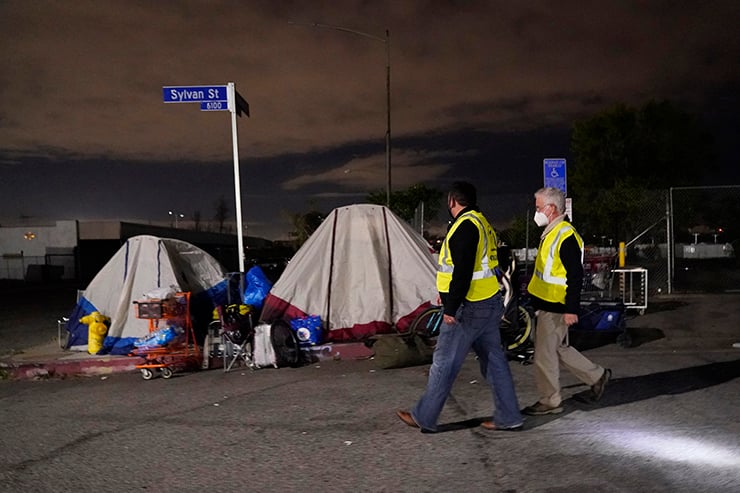In December 2021, six short blocks from the U.S. Capitol, a mentally disturbed transient pushed a young mother to the ground in an unprovoked attack, breaking her two front teeth.
Reacting to the incident, a resident of the tony Capitol Hill neighborhood—where Joe Biden won 86 percent of the vote—said the quiet part out loud: “It just doesn’t normally happen here. It’s unusual, very unusual. But the police will find the guy and … you know they should just have never closed all the mental institutions years ago. Most of those people have real mental issues.”
The 30-year-old attacker, Roman Strickland, was later arrested and held in detention until his mental evaluation will surely result in a recommendation that he be released for further “treatment” on “personal recognizance”—as has occurred with Strickland six times before in D.C. and Virginia for various assault and vandalism charges.
Surely, the refrain will remain the same, as his caseworker told police:
He has schizophrenia and is currently responding to internal stimuli. Roman needs treatment not incarceration. He is street homeless and has been known to stay at the 801 Mens’ Shelter. I would like to advocate for him to be hospitalized for his mental illness. He is not medication compliant and can be aggressive. He responds well to treatment.
But in current-day America “hospitalized” never means detained as much as temporarily delayed from returning to vagrancy and violence. America is struggling to deal with violent, mentally ill homeless people living on the streets of its major cities. The situation the country finds itself in is the result of irresponsible laws written out of the pretense of compassion and enlightened values. Ronald Reagan shares some blame in this due to legislation he enacted as governor of California, as do films like One Flew Over the Cuckoo’s Nest and the pop singer Britney Spears, for creating America’s distorted view of mental illness.
The #FreeBritney movement represented the climax of America’s collective insanity on the topic of mental illness. #FreeBritney involved naïve lemmings on social media campaigning to remove the conservatorship a judge placed over Spears’ affairs as her life was spinning out of control due to mental illness. Rather than seeing this as a necessary step to help a person who had demonstrated an inability to manage her person, her finances, and to care for her dependents, the media and social media influencers spun it as a violation of Spears’ human rights.

(Photograph by William J. Sawchuck)
A half a century ago, the same kind of well-meaning incompetents unleashed an army of zombies onto our streets, who proceeded to defecate and sleep in public, drink and shoot dope, and assault—and sometimes kill—American city dwellers.
They are the homeless—or the “unhoused” in progressive parlance. In France, they go by the delightfully euphemistic acronym SDF, sans domicile fixe (“without a fixed residence”). We used to call them vagrants, transients, tramps, hobos, derelicts, or bums. No more.
Our betters tell us that the homeless truly are victims in need of our resources and respect, but none of our rules or responsibilities. Imposing such constraints “dehumanizes” them and strips them of their dignity and free will. Never mind that the life choices of the homeless inconvenience, interrupt, and endanger the lives and freedoms of their fellow citizens.
It doesn’t help that Hollywood distorts public perception of the problem by lionizing the homeless as capable, deserving, and even heroic. Will Smith’s character in the 2006 film Pursuit of Happyness, for example, rises to success while living in a van. Vagrants are misunderstood and loveable underdogs, we are told.
But the reality is bleaker. The vast majority of the chronically “street homeless” suffer mental illness and addiction—living both outdoors and out of reality.
“There is clearly a link between psychiatric disorders and homelessness,” Dr. Lilanthi Balasuriya, Dr. Eliza Buelt, and Jack Tsai wrote in 2020 in Psychiatric Times. “Mental illness had preceded homelessness in about two-thirds of the cases.”
In the nation’s capital, unsanitary and ramshackle homeless encampments occupy nearly every underpass and many of the municipal and federal parks. According to a 2019 article in Law at the Margins, 80 percent of the occupants at these encampments report “having a diagnosed mental illness, including schizophrenia, ADHD, anxiety, PTSD, depression and bipolar disorder.” Similarly, an analysis by the Los Angeles Times published in October 2019 found that two-thirds of Los Angeles’ vagrants were mentally ill or addicted (often both).
For centuries, under English common law, “lunatics” were wards of the King, under his care, protection, and discretion, but the American colonies lacked the requisite infrastructure to track and provide for the mentally ill in like manner. Eventually, states built asylums in the mid-19th century to house and care for the mentally incompetent if they were committed by family and accompanied by a physician’s certification for admissibility. But indefinite detention was not absolute since the courts recognized the right of habeas corpus and appeal for release initially, and later required a judicial certification and even a jury trial for the detained.
After the muckraking journalist Nellie Bly in 1887 went undercover as a patient in a New York asylum, her reporting on the physical abuses and horrid conditions made waves and ushered in reforms.
By the mid-20th century, the judiciary-led commitment system swung back toward deference to the opinion of medical professionals, who were focused on (often dubious) cures, therapies, and experiments. The new sterile and clinical approach converted asylums into “mental hospitals.”
Enter Nurse Ratched. Hippie pioneer Ken Kesey’s 1962 novel, One Flew Over the Cuckoo’s Nest, which introduced the now-iconic nurse, lambasted the petty tyranny of medical bureaucracy and the indignities perpetrated in mental institutions, especially their practice of brutal procedures such as electroshock therapy. It was a shock to many elite Americans that such sympathetic characters—a war hero and an American Indian traumatized by government abuses—would be confined for being harmless, free-spirited eccentrics.
Kesey’s warped view of the insane as free-spirits reflected the zeitgeist of the 1960s, when libertine self-expression for individuals became the ultimate goal of society and the foremost aim of policy-making.

Randle McMurphy (played by Jack Nicholson) receives electroshock therapy in a mental institution in the 1975 film One Flew Over the Cuckoo’s Nest (Collection Christophel / Alamy Stock Photo)
Into that breach of traditional norms rode the silver-screen cowboy Ronald “Dutch” Reagan. In 1966, the year before Reagan became governor, a California Assembly committee issued a 200-page report, “The Dilemma of Mental Health Commitments in California,” which detailed the quandary of balancing public safety with individual freedom. The self-actualizing technocrats in the legislature were bothered that the Golden State had involuntarily committed 25,000 mentally ill people to mental institutions. Their concern for the “freedom” and “health” of the mentally ill trumped public safety and even the well-being of the patients, who were often a danger to themselves.
The practical innovation of the law that followed—the 1967 Lanterman-Petris-Short (LPS) Act—was that it placed the burden on state and local law enforcement and medical personnel to justify repeatedly along narrow and tangible grounds the need for civil commitment. If they could not meet the high bar for involuntary commitment, they had to release the deranged back into the community. If mentally ill individuals didn’t comply with treatment or the treatment regimen didn’t work, the cycle of arrest and commitment would repeat ad infinitum.

Portrait of Ronald Reagan as governor of California (Reagan Library)
While the “deinstitutionalization” of the LPS Act may have appealed to Governor Reagan’s libertarian streak, the price tag for all these new services to be provided by law enforcement and medical personnel didn’t. Reagan’s reform-oriented aides, however, convinced him that the LPS model could actually save the state money in the long run. So, Reagan made his support (and that of the GOP legislators) for LPS contingent on reduced overall healthcare spending. The policy granted freedom to the confined, self-satisfaction to the social engineers, and a free lunch to the taxpayers, or so it seemed.
Over the next five years, the lunatics abandoned California’s asylums, leaving only 7,000 patients across five institutions. Twenty years later, 95 percent of those who would otherwise be patients in mental hospitals were in the communities—often living on the streets, as E. Fuller Torrey wrote in 1996 in Out of the Shadows: Confronting America’s Mental Illness Crisis.
California’s mental health reform experiment, which made institutionalization a last resort, spread like wildfire across the country. For example, by 1980, the number of psychiatric beds occupied in Massachusetts mental hospitals had declined from the 1953 high-water mark by 90 percent.
The Supreme Court affirmed the trend as well when it decreed in 1975 that mental illness alone could not justify continued civil commitment and that authorities would also be required to prove a patient’s “dangerousness.” In O’Connor v. Donaldson, Justice Potter Stewart’s opinion for the unanimous Court followed Kesey’s trippy logic down the garden path:
May the State fence in the harmless mentally ill solely to save its citizens from exposure to those whose ways are different? One might as well ask if the State, to avoid public unease, could incarcerate all who are physically unattractive or socially eccentric.
In other words, they are misunderstood, and if you say otherwise, you might be a Nazi eugenicist.
Over the next few years, the Court repeatedly raised the bar for involuntary commitment, making the burden of proof for authorities “clear and convincing evidence” that the person is mentally ill and dangerous (1979) and that criminals deemed guilty by mental illness could not be confined if they are no longer mentally ill or dangerous, as delineated in Jones v. United States (1983).
Since pharmaceuticals and therapy, when administered properly and consistently, mitigate an ill person’s symptoms and risk, the Court’s rulings meant release became even more likely after effective treatment in mental hospitals. This was the case even for violent criminally insane patients, who were likely to revert to their former behaviors after their institutional treatment ended.
The asylum doors blew open, the drugs wore off, and the lunatics roamed freely. State-run mental institutions alone held over 300,000 patients in 1950 and 200,000 in 1970 but only 75,000 in 1980 and only 25,000 today—even though the American population has doubled over that time.

The Pennhurst mental asylum in Pennsylvania, originally called the Eastern Pennsylvania State Institution for the Feeble-Minded and Epileptic. It closed in 1987. (Thomas James Caldwell / via Flikr, CC BY-SA 2.0)
Prior to 1980, only a small fraction of Americans viewed the mentally ill as dangerous or “violent toward others.” Surveys show that between 1950 and 1980, Americans’ views of the mentally ill had softened toward sympathy, acceptance, and normalization. But once the asylum gates flung open in the 1980s and 1990s, public opinion shifted toward fear and worry. Fewer were willing to have the mentally ill live near them, marry into their family, or be their coworker. Nevertheless, in 1989, 81 percent of Americans still disagreed that the “best way to handle the mentally ill was to keep them locked up,” according to a poll by the Robert Wood Johnson Foundation.
While Americans continued to “open up” about mental illness, they distinguished between common afflictions, such as depression and anxiety, and severe psychoses such as schizophrenia. Over the last 30 years, Americans’ belief that substance-abuse addicts and schizophrenics are dangerous increased substantially, according to a series of studies reported by the Los Angeles Times in 2019. By 2018, more than two-thirds of the population thought schizophrenics were “violent toward others,” and support for involuntary hospitalization jumped to 59 percent, up from 45 percent in 1996. Even more supported compulsory medication for all schizophrenics, especially those deemed a danger to themselves and others.
Americans’ gut feelings about the danger posed by the severely mentally ill are well-founded. Study after study showed that the mentally ill—particularly schizophrenics and other psychotics—are significantly more prone to violence than the rest of us. In fact, 11 percent of schizophrenic men have been convicted of a violent offense within five years of their diagnosis and are 6.6 times more likely to commit a violent offense, according to a 2014 study by Oxford University.
The chief contributing risk factor for violence among the mentally ill is a coexisting addiction. The vast majority of America’s chronic homeless suffer the overlapping conditions of mental illness and substance abuse, and the results of that volatile and potent mixture is seen on American streets.
The media fixated on a wave of violent anti-Asian hate crimes that occurred in the wake of COVID-19 as a supposed example of bigotry and systemic racism. But criminal records show that the perpetrators of those crimes were almost all mentally disturbed homeless. Most had long criminal histories for petty and “minor” violent crimes, including random assaults, but with few consequences.
It is not surprising that the homeless themselves are often victims of violence, for they are vulnerable and desperate, without support networks or trust in authorities. And the perpetrators of this violence usually are, of course, other homeless. The street is governed not by the rule of law but by the rule of the jungle. The strong prey on the weak: robbing, raping, and killing with near impunity, since reports of these crimes are often anonymous, unreliable, based on uncooperative witnesses, and usually—due to the romanticization of the homeless and insane—perpetrated by the legally unaccountable, since courts tend to rule that the few who make it to trial are “not responsible by mental defect.”
But the deinstitutionalization lobby blames a lack of funding and stigma for the woes of the mentally ill homeless. Of late, this lobby has been joined in the chorus by the decarceration lobby (i.e. prison abolitionists), who note that the American jail and prison population grew exponentially just as the mental institutions shuttered. The correlation is, in fact, strong. By 2012, according to the Bureau of Justice Statistics, 14 percent of federal and state prisoners and 26 percent of jailed inmates had serious psychological distress that impaired functioning.
That means that 400,000 mentally ill are held in America’s prisons and jails, compared with less than 40,000 in mental hospitals—a total inversion of the ratios from 50 years ago.
In Los Angeles, according to police crime data, more than 60 percent of the crime attributed to the homeless is considered violent, yet in the overall population, violent crime accounts for only 20 percent of all criminal activity. In both 2020 and 2021, 15 percent of all violent crime was committed by the homeless, who were often also mentally ill.
Both total crime and violent offenses are growing in the City of Angels, as “skid row” metastasizes across the downtown landscape—a shantytown now stretching across six square miles from the USC campus to Dodger Stadium and, ironically, swallowing up both Los Angeles City Hall and the county office buildings. The city’s homeless population, in fact, rose by 53 percent in 2020—which is not surprising since the city has been providing hotel rooms to transients in an effort to mitigate the spread of COVID-19.
It’s not just Los Angeles. In the Bay Area, too, homelessness is skyrocketing—up 31 percent in San Francisco, 40 percent in San Jose, and 47 percent in Oakland since 2017 alone. In San Francisco, one neighborhood has seen a 285 percent increase in homeless camps, ABC News reported in 2020.

And why the surge in vagrancy of late? Hint: it’s not COVID or housing costs. It’s the courts, again.
In 2018’s Martin v. Boise, the Ninth Circuit Court of Appeals deemed it “cruel and unusual punishment” for cities to ban public camping if they lack enough shelter beds to accommodate the homeless population. The situation (pre-COVID) was so bad that the leaders of America’s most progressive cities begged the Supreme Court to let them clear the camps, but the Court refused to even hear the challenge to the decision, forcing the nine Western states, including California, to tolerate the unsanitary and dangerous shantytowns.
And those urine- and feces-filled open-air asylums ballooned when pro-criminal advocates and their acolytes in government opened the prison doors “to ease COVID” risks. But the influx of jailbirds has only brought more disease to the streets, and conditions for the homeless and mentally ill have become truly horrific as “medieval” diseases like typhus, tuberculosis, shigella, dysentery, and hepatitis A—previously uncommon outside the third world—now stalk the streets of American metropolises.
And familiarity does breed contempt, as studies show that with increased exposure over time, most medical professionals and the public in general only increase their fear and hostility toward the mentally ill. The Journal of Community Psychology published the results of a 2016 survey finding that 74 percent feel less compassionate than they used to as the homelessness problem grew in their communities, and 81 percent of Americans want the seriously mentally ill committed for treatment.
But the legal system ensures they cannot be treated for long.
According to a July 2020 California auditor’s report, during a five-year period from 2014 to 2019, over 10,000 individuals in Los Angeles County alone were put on more than ten “72-hour holds.” And since it’s nearly impossible to convert those holds into longer involuntary and potentially indefinite commitments, they end up back on the streets in regular intervals.
The chief recourse to this is a “conservatorship of the person” to compel compliance with treatment and make a third-party guardian responsible for the care of the afflicted person. In addition to the “person” form, conservatorships can take an “estate” form, which is mostly used to guard the assets of the elderly and infirm. An individual can be under one or the other or both conservatorships at any time.
And that’s why Britney Spears’ case is so distressing. As social-media activists and fans pushed to end Spears’ conservatorship (she was under limited forms of both), Madonna likened it to “slavery.” Yet this tool is a last resort for families and others to intervene with the desperate souls who suffer serious mental problems and addiction, and who sleep on the streets.
And these conservatorships—held by the county or family and friends—are exceedingly difficult to obtain from a court, requiring a “beyond reasonable doubt” burden of proof. Those of limited duration, say 12 months, require the guardian (often the government) to reapply for an extension, which must be reviewed by a court.
This tool, like involuntary mental health detentions, is being utilized less and less even as the homeless and vulnerable mentally ill population grows. According to the California Department of Health Care Services, temporary and permanent conservatorships fell by almost 50 percent from 2010 to 2015. And in Oakland’s Alameda County, conservatorships dropped by more than 40 percent during the same period, resulting in at least 10,000 fewer impositions.
By all but shuttering the mental asylums, California—and the nation—have nowhere to put the mentally ill, and authorities have extremely limited recourse due to the shortsighted, naïve, and smug social engineers and activists of past and current generations.
Now, thanks to the Supreme Court’s indifference, the disease-addled, drug-addicted, delusion-driven zombies are coming to your town, too, demanding to camp, shoot up, and defecate wherever and whenever they please. And they can do it with impunity because America gave them compassionate immunity from legal consequences.
The history of American policy toward the homeless poses existential questions about free will, dignity, and individual autonomy. As a practical and moral matter, however, how does tolerating self-destructive behavior, violence, and the utter misery festering on our streets make us enlightened beings? How does it make American communities livable for us—or them?
Instead of facing the filth and fear on the streets, our modern betters and keyboard warriors want us to sympathize with Britney Spears’ plight or Hollywood’s romantic version of the homeless and mentally ill.
But, in fact, our embrace of the continued so-called “freedom” of the deluded and derelict will only exacerbate their problems and ours.
Maybe we’re the ones who are really crazy.
Top image: Los Angeles City Council Member Paul Krekorian (right) walks past tents where people are living in the North Hollywood section of Los Angeles on Feb. 22, 2022 (Marcio Jose Sanchez / Associated Press)

Leave a Reply